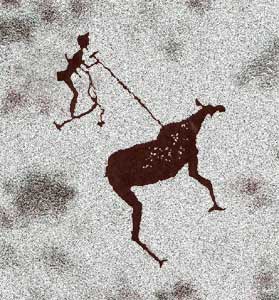Ages ago now, the people on this planet made quite a historic anthropological shift, deciding — en masse in some cases — to hunker down and grow crops and herd animals, rather than keep the ramblin' lifestyle to which they had been accustomed. All that running and chasing and rummaging through berry bushes must have been exhausting after awhile.
 At any rate, this Agricultural Revolution made it a bit more easy and less life-threatening for humans to stick around the newly settled land, and so they did just that. Now, the one thing that they continued to do was eat, and so they continued to use their teeth to chew and so they, in turn, found slightly different uses for their teeth and jawbones, no longer needing the massive amounts of teeth and huge jaws to rip into the flesh of a freshly killed antelope, lion, or wildebeest.
At any rate, this Agricultural Revolution made it a bit more easy and less life-threatening for humans to stick around the newly settled land, and so they did just that. Now, the one thing that they continued to do was eat, and so they continued to use their teeth to chew and so they, in turn, found slightly different uses for their teeth and jawbones, no longer needing the massive amounts of teeth and huge jaws to rip into the flesh of a freshly killed antelope, lion, or wildebeest.
This according to a new study by a physical anthropologist out of the University of Kent. This person claims that as humans ate foods that were softer and more processed, their teeth needed to be less and less fierce and sharp and so, during the ages of evolution that followed, got less and less exercise and so, as a whole, became less and less necessary. And as the teeth got used less and less, the jawbones that surrounded those teeth got less and less use and so, over time, got smaller and smaller.
The problem was, though, that the teeth continued to grow, at a similar size, in a space that grew smaller and smaller — which explains why the people of today have wisdom teeth that have no use other than to cause pain until they are removed.
 Now, this is certainly not the case with all modern humans. In fact, some people are born without wisdom teeth of any kind. (Whether this affects the amount of wisdom that they gather during their lifetimes is an entirely independent manner.) But many people are born with their wisdom teeth intact, and these teeth mature so much that they are impacted and don't serve any useful purpose anymore. Why? Because the jawbone that previously allowed the teeth access to food has become smaller over time, such that modern humans would be really hard-pressed to use those wisdom teeth for anything at all.
Now, this is certainly not the case with all modern humans. In fact, some people are born without wisdom teeth of any kind. (Whether this affects the amount of wisdom that they gather during their lifetimes is an entirely independent manner.) But many people are born with their wisdom teeth intact, and these teeth mature so much that they are impacted and don't serve any useful purpose anymore. Why? Because the jawbone that previously allowed the teeth access to food has become smaller over time, such that modern humans would be really hard-pressed to use those wisdom teeth for anything at all.
Modern dentists don't much care, though. They're quite happy to continue to extract these vestigial sources of pain, to the tune of several hundred dollars a pop. We don't have a whole lot of records about dentistry in the distant past. Wisdom teeth probably weren't much of an issue in the way we view them now because they were being used. But ancient peoples still would have had tooth pain, of course, because that is something that we have whether we use the teeth or not.
Anyway, the scientific study compared 11 human populations from across the world. Results are in the November 21 Proceedings of the National Academy of Sciences.
